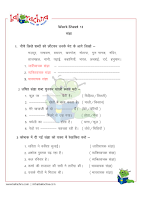Before we introduce
the grammatical term, gender ( लिंग) it is important to point it out to the kids that-
· Every object,
person, place, expression, state, thing – animate or inanimate has a name. It's
grammatical term is noun.
· Every noun is
assigned to two grammatical genders, masculine – पुल्लिंग and feminine – स्त्रीलिंग. Unlike Sanskrit,
there is no neuter gender – नपुंसकलिंग in the Hindi language
· At this stage give some
examples of common objects in sentence form –
लड़का बैठा है। ( पु.)
किताब फट गई।
(स्त्री.)
गिलास गिर गया।
(पु.)
· Point it out to
them that they have already been using the terms पुल्लिंग/ स्त्रीलिंग informally.
· When we ask them to
identify an object as to their gender – पुल्लिंग/ स्त्रीलिंग, encourage them to
form a simple sentence so they can easily identify its gender.
· It is important to point it out to them that in a sentence, words
related to the noun like determiners, pronouns, adjectives, verbs change their
form according to the gender of the noun they refer to. e.g.-
छाता हवा में उड़ गया। ( पु.)
छतरी हवा में उड़ गई। (स्त्री.)
At the early level
of primary classes, it is important they identify, pronounce and
learn the spelling of पुल्लिंग/ स्त्रीलिंग. I am uploading pictorial worksheets and hope they are helpful to parents and fellow teachers.
Please leave a comment and follow the blog. Happy teaching!!!!








































